University Course: Facility Risk Management Report - Yard Hotel
VerifiedAdded on 2021/10/30
|7
|1503
|166
Report
AI Summary
This report provides a comprehensive analysis of facility risk management at the Yard Hotel concert venue. The venue, a 10,000-seat capacity hall, is assessed based on its service bar, kitchen, equipment, and overall structure. The report discusses venue condition assessment using a Microsoft Excel spreadsheet, evaluating factors such as conditioning index, life expectancy, and age. It emphasizes the importance of quality in design, construction, and operation, covering functional, constructive, economic, and aesthetic features. The report also addresses facility risk management, including factors affecting the quality of construction and installation work. The report references the importance of verandas and outdoor equipment. The report concludes with references to relevant academic sources.
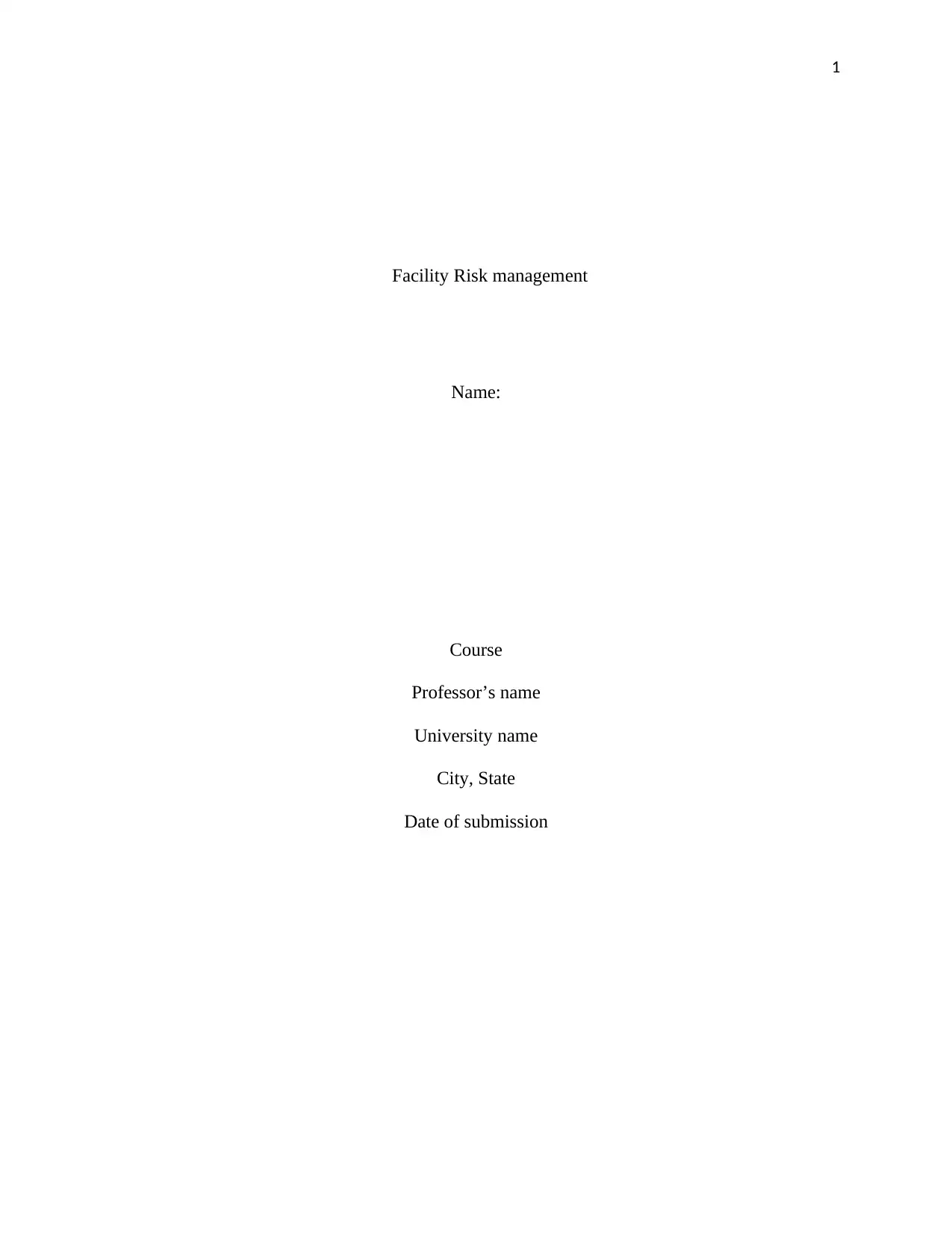
1
Facility Risk management
Name:
Course
Professor’s name
University name
City, State
Date of submission
Facility Risk management
Name:
Course
Professor’s name
University name
City, State
Date of submission
Paraphrase This Document
Need a fresh take? Get an instant paraphrase of this document with our AI Paraphraser
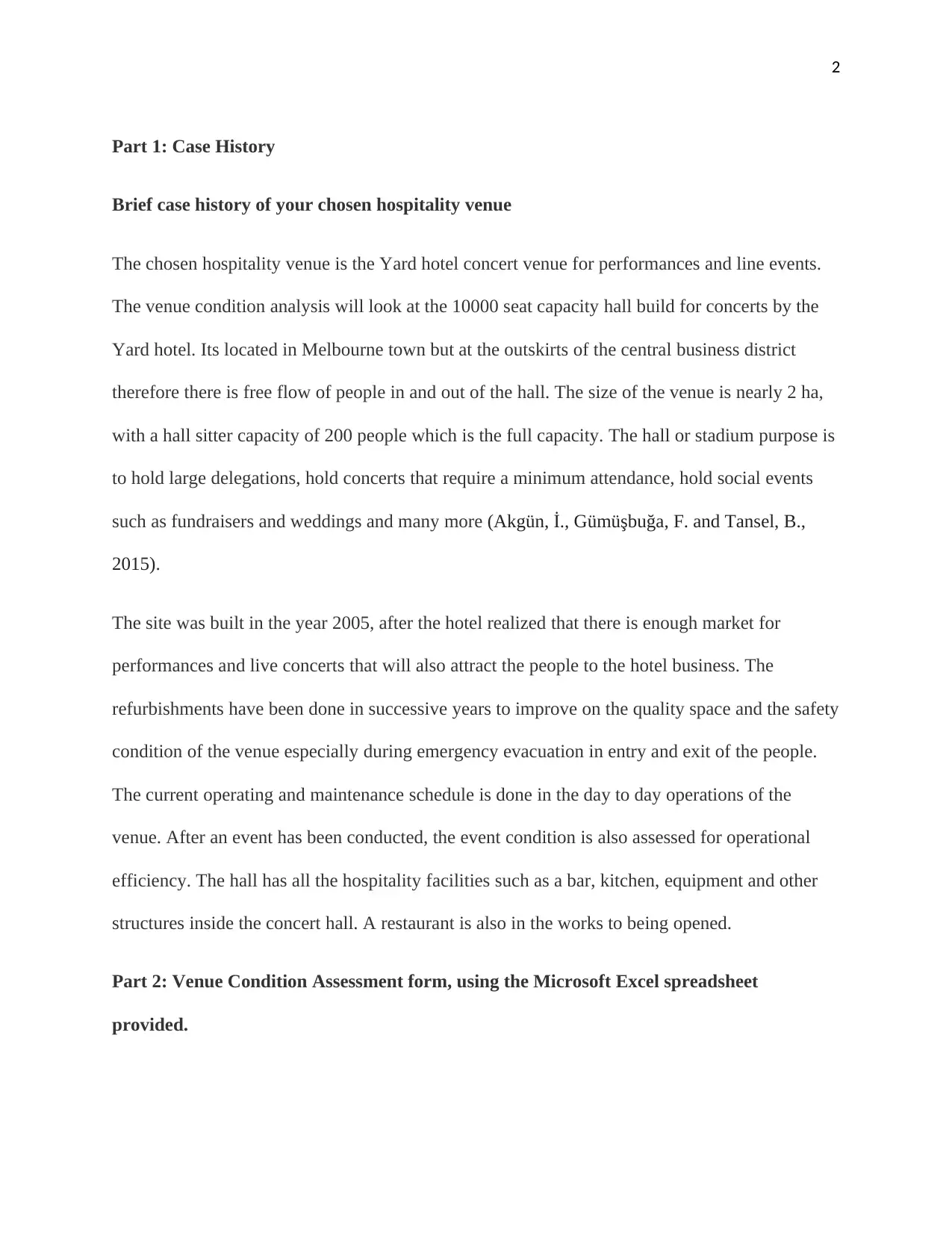
2
Part 1: Case History
Brief case history of your chosen hospitality venue
The chosen hospitality venue is the Yard hotel concert venue for performances and line events.
The venue condition analysis will look at the 10000 seat capacity hall build for concerts by the
Yard hotel. Its located in Melbourne town but at the outskirts of the central business district
therefore there is free flow of people in and out of the hall. The size of the venue is nearly 2 ha,
with a hall sitter capacity of 200 people which is the full capacity. The hall or stadium purpose is
to hold large delegations, hold concerts that require a minimum attendance, hold social events
such as fundraisers and weddings and many more (Akgün, İ., Gümüşbuğa, F. and Tansel, B.,
2015).
The site was built in the year 2005, after the hotel realized that there is enough market for
performances and live concerts that will also attract the people to the hotel business. The
refurbishments have been done in successive years to improve on the quality space and the safety
condition of the venue especially during emergency evacuation in entry and exit of the people.
The current operating and maintenance schedule is done in the day to day operations of the
venue. After an event has been conducted, the event condition is also assessed for operational
efficiency. The hall has all the hospitality facilities such as a bar, kitchen, equipment and other
structures inside the concert hall. A restaurant is also in the works to being opened.
Part 2: Venue Condition Assessment form, using the Microsoft Excel spreadsheet
provided.
Part 1: Case History
Brief case history of your chosen hospitality venue
The chosen hospitality venue is the Yard hotel concert venue for performances and line events.
The venue condition analysis will look at the 10000 seat capacity hall build for concerts by the
Yard hotel. Its located in Melbourne town but at the outskirts of the central business district
therefore there is free flow of people in and out of the hall. The size of the venue is nearly 2 ha,
with a hall sitter capacity of 200 people which is the full capacity. The hall or stadium purpose is
to hold large delegations, hold concerts that require a minimum attendance, hold social events
such as fundraisers and weddings and many more (Akgün, İ., Gümüşbuğa, F. and Tansel, B.,
2015).
The site was built in the year 2005, after the hotel realized that there is enough market for
performances and live concerts that will also attract the people to the hotel business. The
refurbishments have been done in successive years to improve on the quality space and the safety
condition of the venue especially during emergency evacuation in entry and exit of the people.
The current operating and maintenance schedule is done in the day to day operations of the
venue. After an event has been conducted, the event condition is also assessed for operational
efficiency. The hall has all the hospitality facilities such as a bar, kitchen, equipment and other
structures inside the concert hall. A restaurant is also in the works to being opened.
Part 2: Venue Condition Assessment form, using the Microsoft Excel spreadsheet
provided.
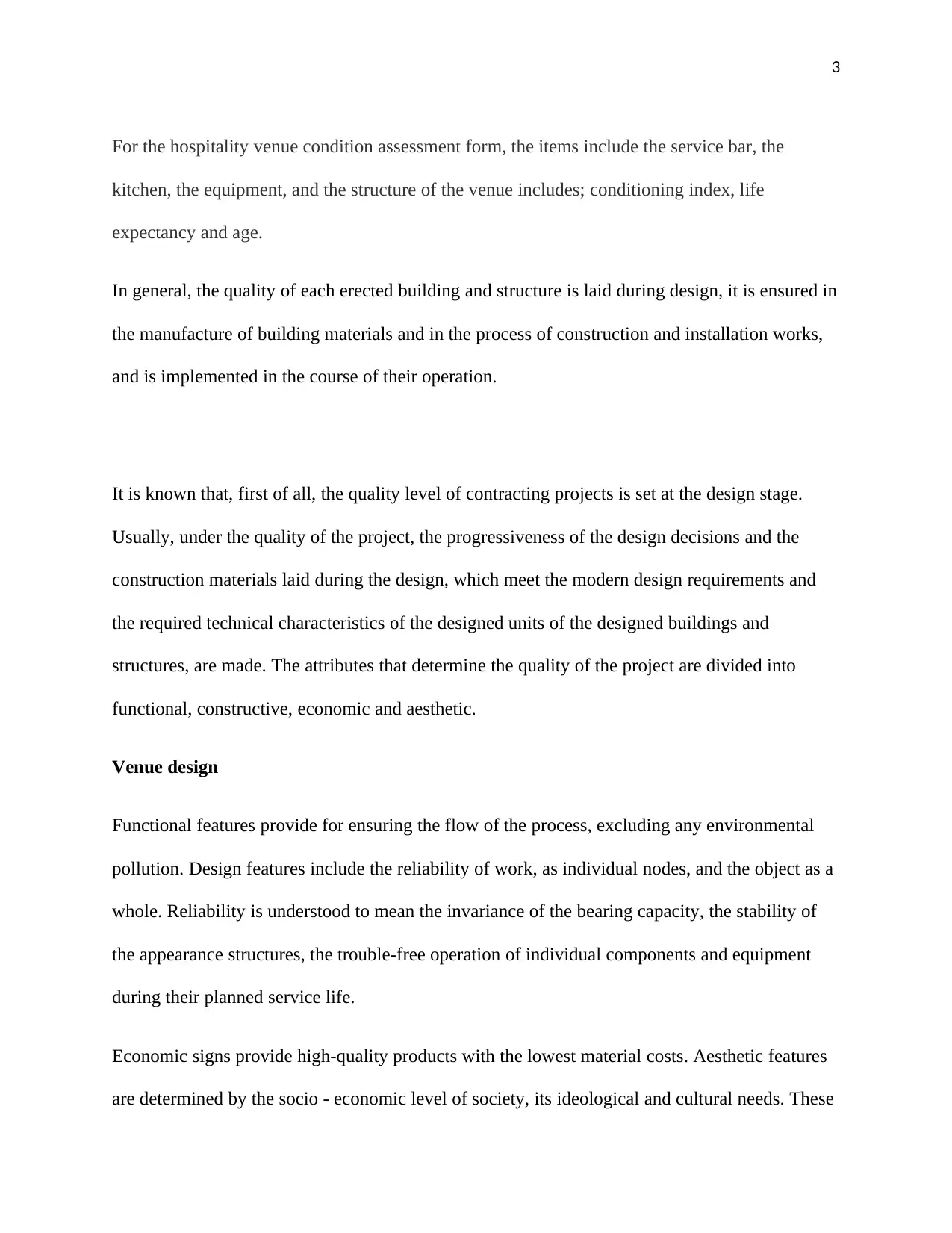
3
For the hospitality venue condition assessment form, the items include the service bar, the
kitchen, the equipment, and the structure of the venue includes; conditioning index, life
expectancy and age.
In general, the quality of each erected building and structure is laid during design, it is ensured in
the manufacture of building materials and in the process of construction and installation works,
and is implemented in the course of their operation.
It is known that, first of all, the quality level of contracting projects is set at the design stage.
Usually, under the quality of the project, the progressiveness of the design decisions and the
construction materials laid during the design, which meet the modern design requirements and
the required technical characteristics of the designed units of the designed buildings and
structures, are made. The attributes that determine the quality of the project are divided into
functional, constructive, economic and aesthetic.
Venue design
Functional features provide for ensuring the flow of the process, excluding any environmental
pollution. Design features include the reliability of work, as individual nodes, and the object as a
whole. Reliability is understood to mean the invariance of the bearing capacity, the stability of
the appearance structures, the trouble-free operation of individual components and equipment
during their planned service life.
Economic signs provide high-quality products with the lowest material costs. Aesthetic features
are determined by the socio - economic level of society, its ideological and cultural needs. These
For the hospitality venue condition assessment form, the items include the service bar, the
kitchen, the equipment, and the structure of the venue includes; conditioning index, life
expectancy and age.
In general, the quality of each erected building and structure is laid during design, it is ensured in
the manufacture of building materials and in the process of construction and installation works,
and is implemented in the course of their operation.
It is known that, first of all, the quality level of contracting projects is set at the design stage.
Usually, under the quality of the project, the progressiveness of the design decisions and the
construction materials laid during the design, which meet the modern design requirements and
the required technical characteristics of the designed units of the designed buildings and
structures, are made. The attributes that determine the quality of the project are divided into
functional, constructive, economic and aesthetic.
Venue design
Functional features provide for ensuring the flow of the process, excluding any environmental
pollution. Design features include the reliability of work, as individual nodes, and the object as a
whole. Reliability is understood to mean the invariance of the bearing capacity, the stability of
the appearance structures, the trouble-free operation of individual components and equipment
during their planned service life.
Economic signs provide high-quality products with the lowest material costs. Aesthetic features
are determined by the socio - economic level of society, its ideological and cultural needs. These
⊘ This is a preview!⊘
Do you want full access?
Subscribe today to unlock all pages.

Trusted by 1+ million students worldwide
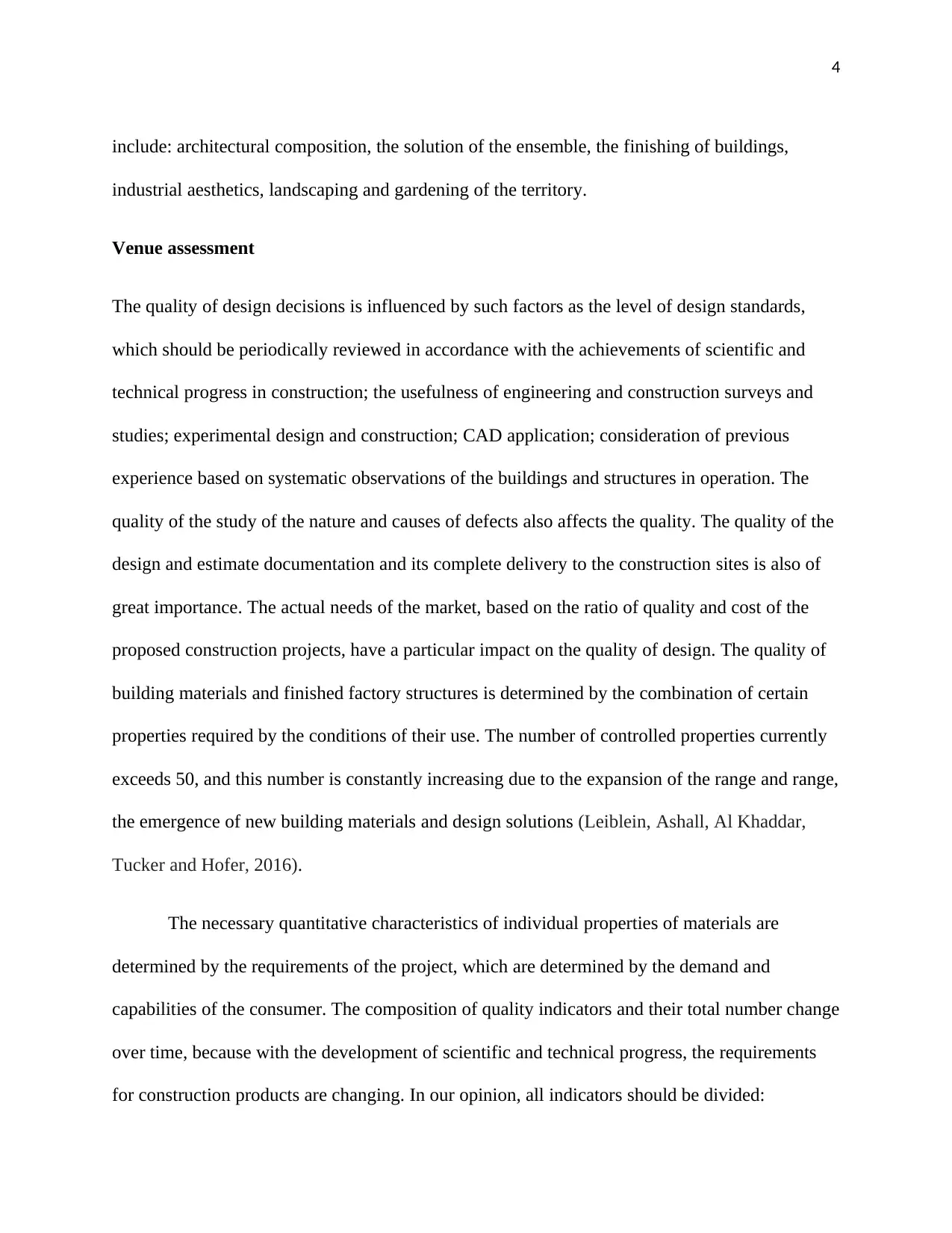
4
include: architectural composition, the solution of the ensemble, the finishing of buildings,
industrial aesthetics, landscaping and gardening of the territory.
Venue assessment
The quality of design decisions is influenced by such factors as the level of design standards,
which should be periodically reviewed in accordance with the achievements of scientific and
technical progress in construction; the usefulness of engineering and construction surveys and
studies; experimental design and construction; CAD application; consideration of previous
experience based on systematic observations of the buildings and structures in operation. The
quality of the study of the nature and causes of defects also affects the quality. The quality of the
design and estimate documentation and its complete delivery to the construction sites is also of
great importance. The actual needs of the market, based on the ratio of quality and cost of the
proposed construction projects, have a particular impact on the quality of design. The quality of
building materials and finished factory structures is determined by the combination of certain
properties required by the conditions of their use. The number of controlled properties currently
exceeds 50, and this number is constantly increasing due to the expansion of the range and range,
the emergence of new building materials and design solutions (Leiblein, Ashall, Al Khaddar,
Tucker and Hofer, 2016).
The necessary quantitative characteristics of individual properties of materials are
determined by the requirements of the project, which are determined by the demand and
capabilities of the consumer. The composition of quality indicators and their total number change
over time, because with the development of scientific and technical progress, the requirements
for construction products are changing. In our opinion, all indicators should be divided:
include: architectural composition, the solution of the ensemble, the finishing of buildings,
industrial aesthetics, landscaping and gardening of the territory.
Venue assessment
The quality of design decisions is influenced by such factors as the level of design standards,
which should be periodically reviewed in accordance with the achievements of scientific and
technical progress in construction; the usefulness of engineering and construction surveys and
studies; experimental design and construction; CAD application; consideration of previous
experience based on systematic observations of the buildings and structures in operation. The
quality of the study of the nature and causes of defects also affects the quality. The quality of the
design and estimate documentation and its complete delivery to the construction sites is also of
great importance. The actual needs of the market, based on the ratio of quality and cost of the
proposed construction projects, have a particular impact on the quality of design. The quality of
building materials and finished factory structures is determined by the combination of certain
properties required by the conditions of their use. The number of controlled properties currently
exceeds 50, and this number is constantly increasing due to the expansion of the range and range,
the emergence of new building materials and design solutions (Leiblein, Ashall, Al Khaddar,
Tucker and Hofer, 2016).
The necessary quantitative characteristics of individual properties of materials are
determined by the requirements of the project, which are determined by the demand and
capabilities of the consumer. The composition of quality indicators and their total number change
over time, because with the development of scientific and technical progress, the requirements
for construction products are changing. In our opinion, all indicators should be divided:
Paraphrase This Document
Need a fresh take? Get an instant paraphrase of this document with our AI Paraphraser
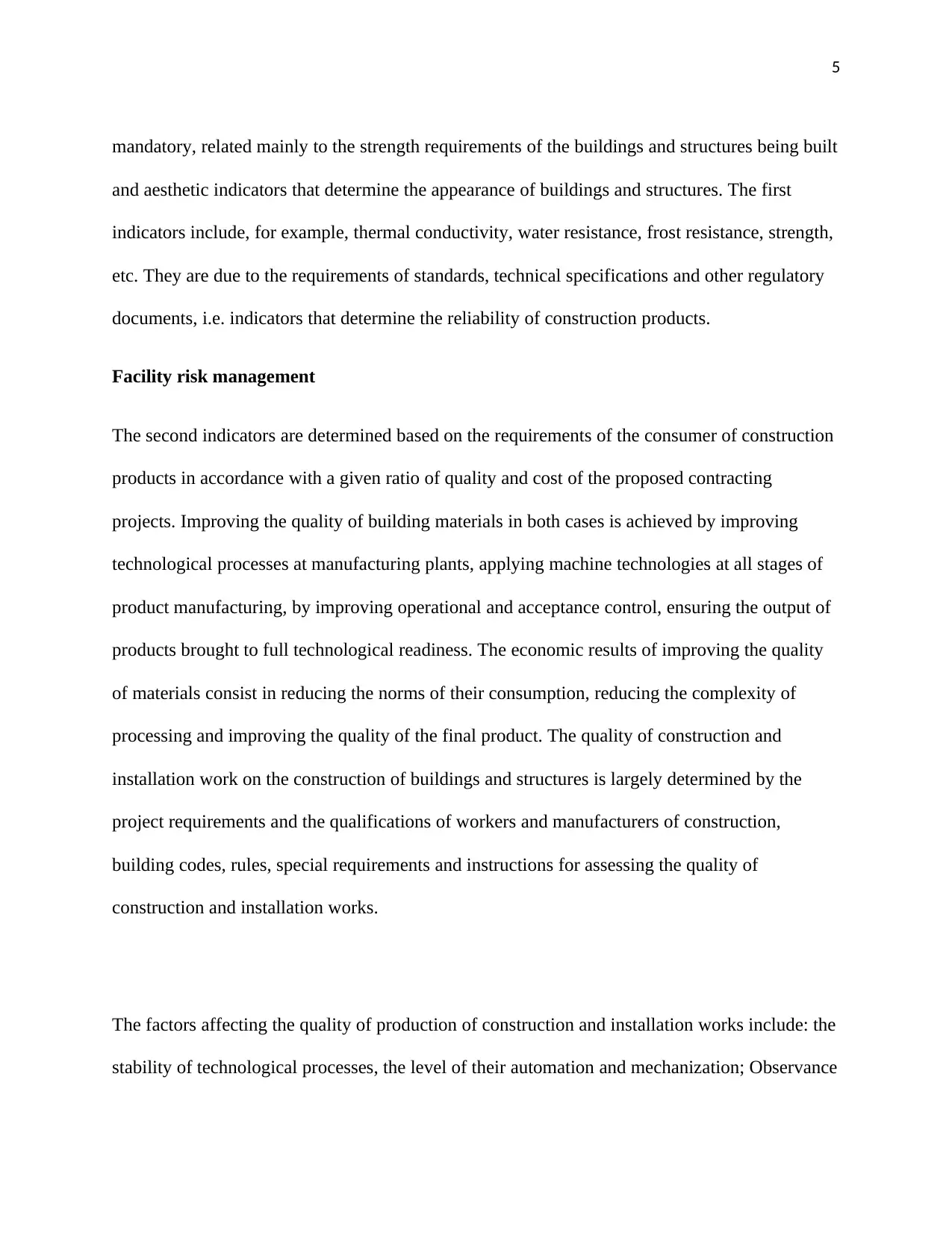
5
mandatory, related mainly to the strength requirements of the buildings and structures being built
and aesthetic indicators that determine the appearance of buildings and structures. The first
indicators include, for example, thermal conductivity, water resistance, frost resistance, strength,
etc. They are due to the requirements of standards, technical specifications and other regulatory
documents, i.e. indicators that determine the reliability of construction products.
Facility risk management
The second indicators are determined based on the requirements of the consumer of construction
products in accordance with a given ratio of quality and cost of the proposed contracting
projects. Improving the quality of building materials in both cases is achieved by improving
technological processes at manufacturing plants, applying machine technologies at all stages of
product manufacturing, by improving operational and acceptance control, ensuring the output of
products brought to full technological readiness. The economic results of improving the quality
of materials consist in reducing the norms of their consumption, reducing the complexity of
processing and improving the quality of the final product. The quality of construction and
installation work on the construction of buildings and structures is largely determined by the
project requirements and the qualifications of workers and manufacturers of construction,
building codes, rules, special requirements and instructions for assessing the quality of
construction and installation works.
The factors affecting the quality of production of construction and installation works include: the
stability of technological processes, the level of their automation and mechanization; Observance
mandatory, related mainly to the strength requirements of the buildings and structures being built
and aesthetic indicators that determine the appearance of buildings and structures. The first
indicators include, for example, thermal conductivity, water resistance, frost resistance, strength,
etc. They are due to the requirements of standards, technical specifications and other regulatory
documents, i.e. indicators that determine the reliability of construction products.
Facility risk management
The second indicators are determined based on the requirements of the consumer of construction
products in accordance with a given ratio of quality and cost of the proposed contracting
projects. Improving the quality of building materials in both cases is achieved by improving
technological processes at manufacturing plants, applying machine technologies at all stages of
product manufacturing, by improving operational and acceptance control, ensuring the output of
products brought to full technological readiness. The economic results of improving the quality
of materials consist in reducing the norms of their consumption, reducing the complexity of
processing and improving the quality of the final product. The quality of construction and
installation work on the construction of buildings and structures is largely determined by the
project requirements and the qualifications of workers and manufacturers of construction,
building codes, rules, special requirements and instructions for assessing the quality of
construction and installation works.
The factors affecting the quality of production of construction and installation works include: the
stability of technological processes, the level of their automation and mechanization; Observance
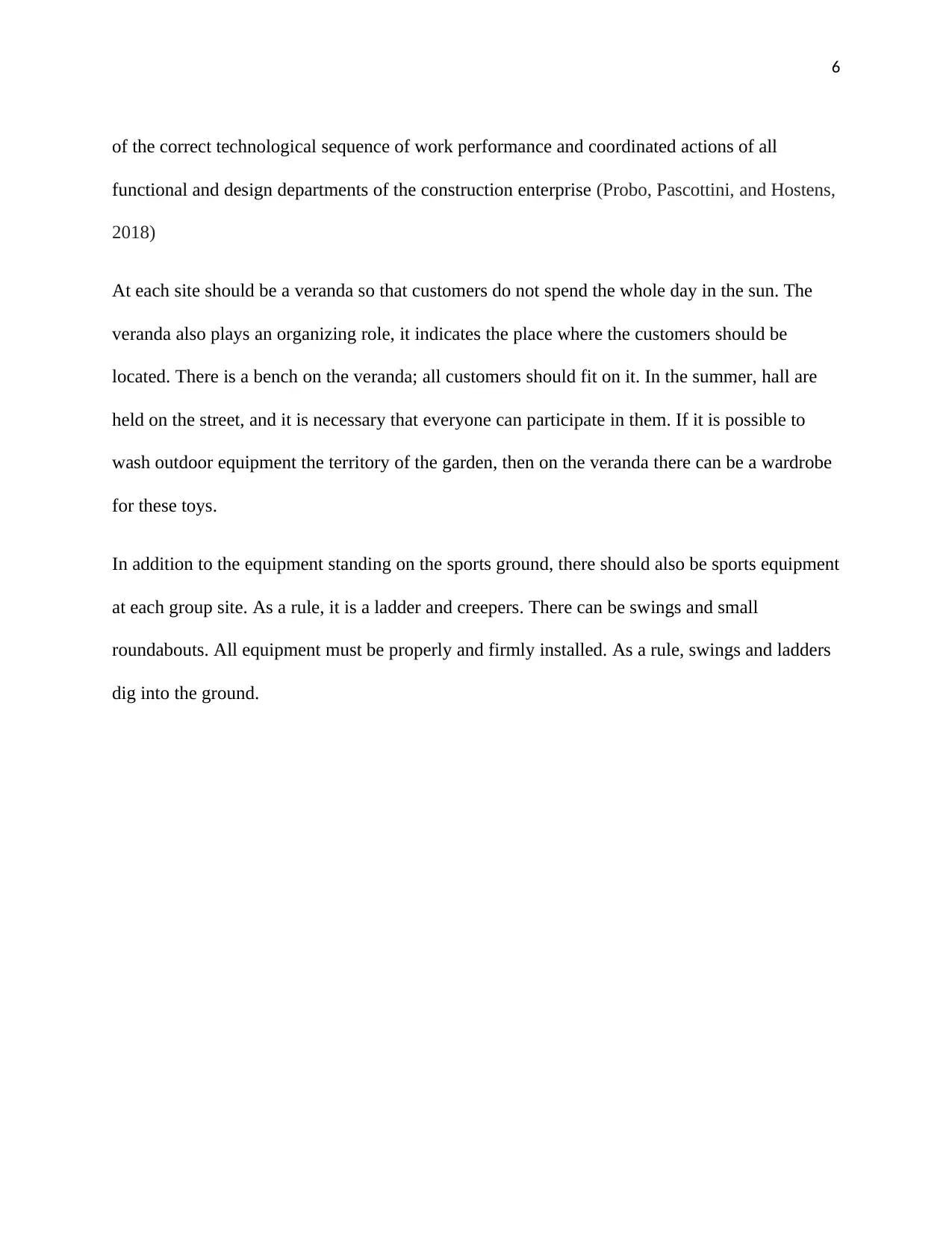
6
of the correct technological sequence of work performance and coordinated actions of all
functional and design departments of the construction enterprise (Probo, Pascottini, and Hostens,
2018)
At each site should be a veranda so that customers do not spend the whole day in the sun. The
veranda also plays an organizing role, it indicates the place where the customers should be
located. There is a bench on the veranda; all customers should fit on it. In the summer, hall are
held on the street, and it is necessary that everyone can participate in them. If it is possible to
wash outdoor equipment the territory of the garden, then on the veranda there can be a wardrobe
for these toys.
In addition to the equipment standing on the sports ground, there should also be sports equipment
at each group site. As a rule, it is a ladder and creepers. There can be swings and small
roundabouts. All equipment must be properly and firmly installed. As a rule, swings and ladders
dig into the ground.
of the correct technological sequence of work performance and coordinated actions of all
functional and design departments of the construction enterprise (Probo, Pascottini, and Hostens,
2018)
At each site should be a veranda so that customers do not spend the whole day in the sun. The
veranda also plays an organizing role, it indicates the place where the customers should be
located. There is a bench on the veranda; all customers should fit on it. In the summer, hall are
held on the street, and it is necessary that everyone can participate in them. If it is possible to
wash outdoor equipment the territory of the garden, then on the veranda there can be a wardrobe
for these toys.
In addition to the equipment standing on the sports ground, there should also be sports equipment
at each group site. As a rule, it is a ladder and creepers. There can be swings and small
roundabouts. All equipment must be properly and firmly installed. As a rule, swings and ladders
dig into the ground.
⊘ This is a preview!⊘
Do you want full access?
Subscribe today to unlock all pages.

Trusted by 1+ million students worldwide
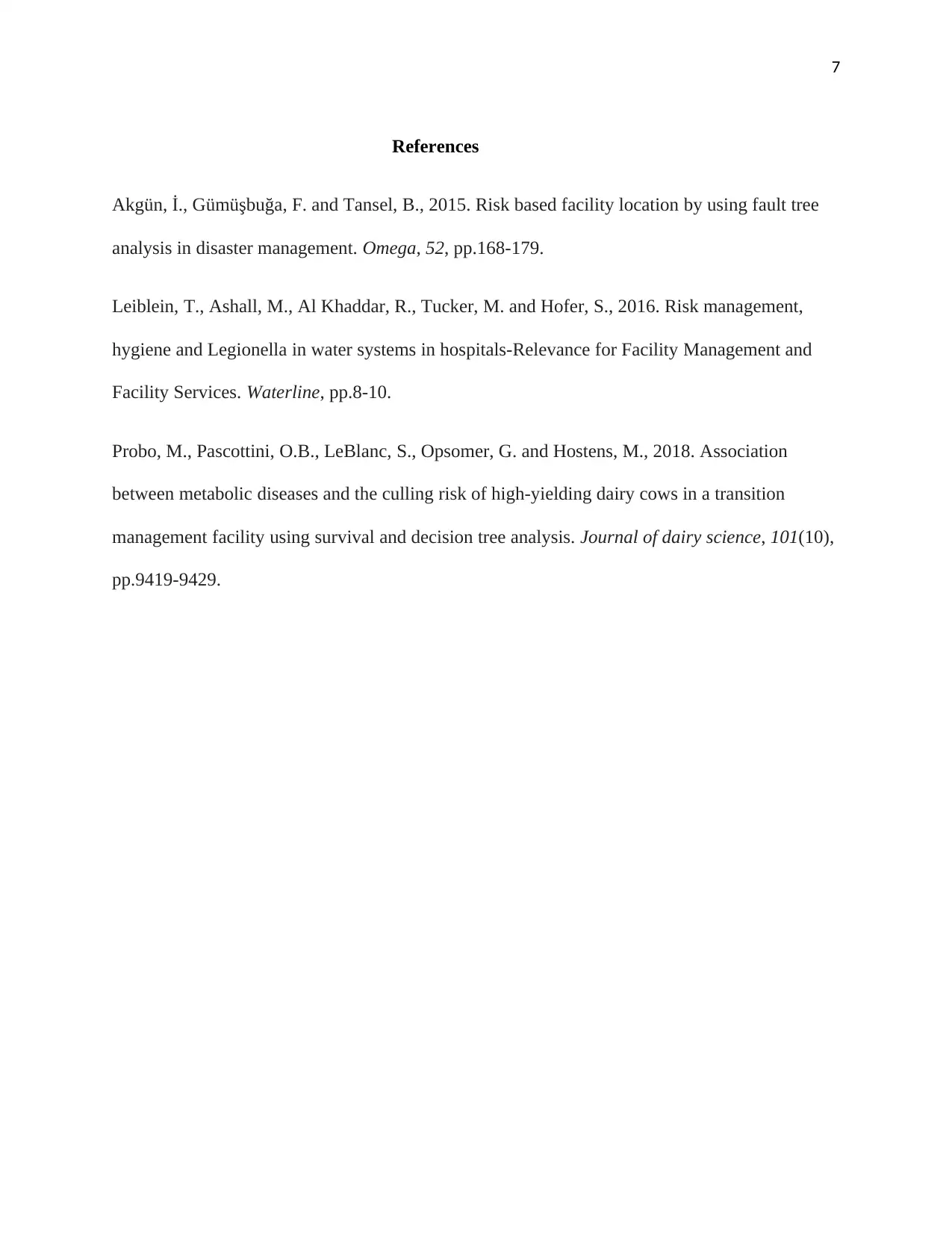
7
References
Akgün, İ., Gümüşbuğa, F. and Tansel, B., 2015. Risk based facility location by using fault tree
analysis in disaster management. Omega, 52, pp.168-179.
Leiblein, T., Ashall, M., Al Khaddar, R., Tucker, M. and Hofer, S., 2016. Risk management,
hygiene and Legionella in water systems in hospitals-Relevance for Facility Management and
Facility Services. Waterline, pp.8-10.
Probo, M., Pascottini, O.B., LeBlanc, S., Opsomer, G. and Hostens, M., 2018. Association
between metabolic diseases and the culling risk of high-yielding dairy cows in a transition
management facility using survival and decision tree analysis. Journal of dairy science, 101(10),
pp.9419-9429.
References
Akgün, İ., Gümüşbuğa, F. and Tansel, B., 2015. Risk based facility location by using fault tree
analysis in disaster management. Omega, 52, pp.168-179.
Leiblein, T., Ashall, M., Al Khaddar, R., Tucker, M. and Hofer, S., 2016. Risk management,
hygiene and Legionella in water systems in hospitals-Relevance for Facility Management and
Facility Services. Waterline, pp.8-10.
Probo, M., Pascottini, O.B., LeBlanc, S., Opsomer, G. and Hostens, M., 2018. Association
between metabolic diseases and the culling risk of high-yielding dairy cows in a transition
management facility using survival and decision tree analysis. Journal of dairy science, 101(10),
pp.9419-9429.
1 out of 7
Related Documents
Your All-in-One AI-Powered Toolkit for Academic Success.
+13062052269
info@desklib.com
Available 24*7 on WhatsApp / Email
![[object Object]](/_next/static/media/star-bottom.7253800d.svg)
Unlock your academic potential
Copyright © 2020–2025 A2Z Services. All Rights Reserved. Developed and managed by ZUCOL.




